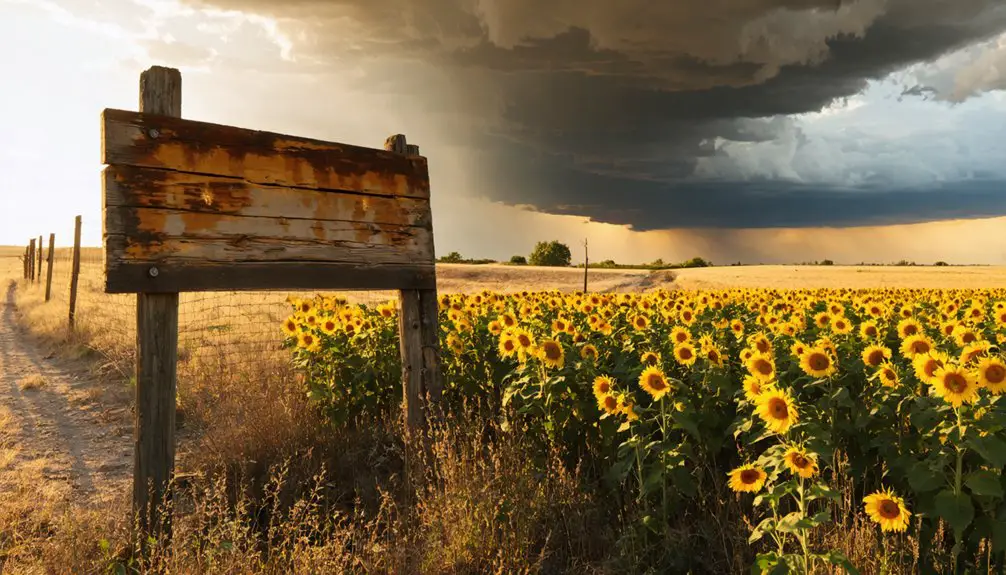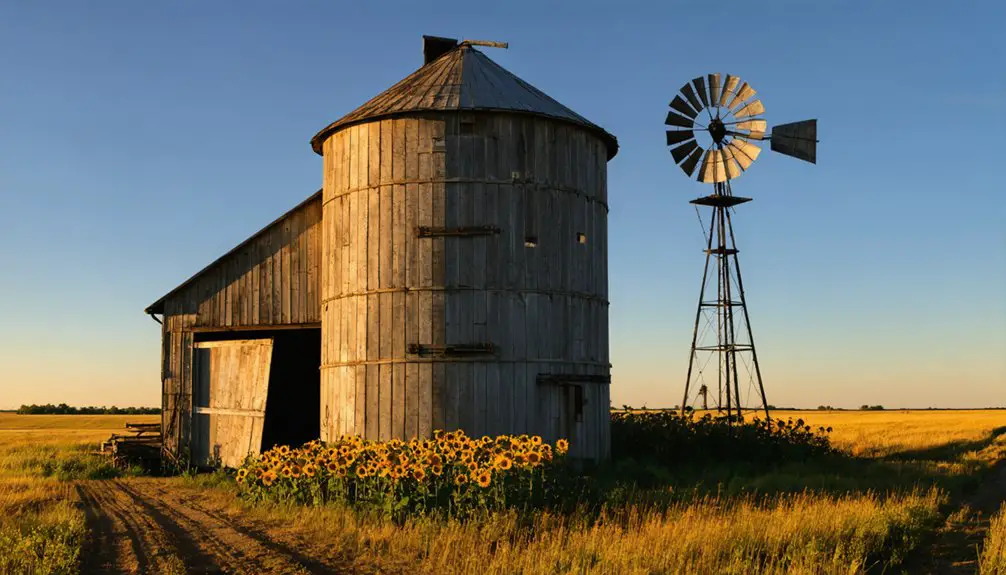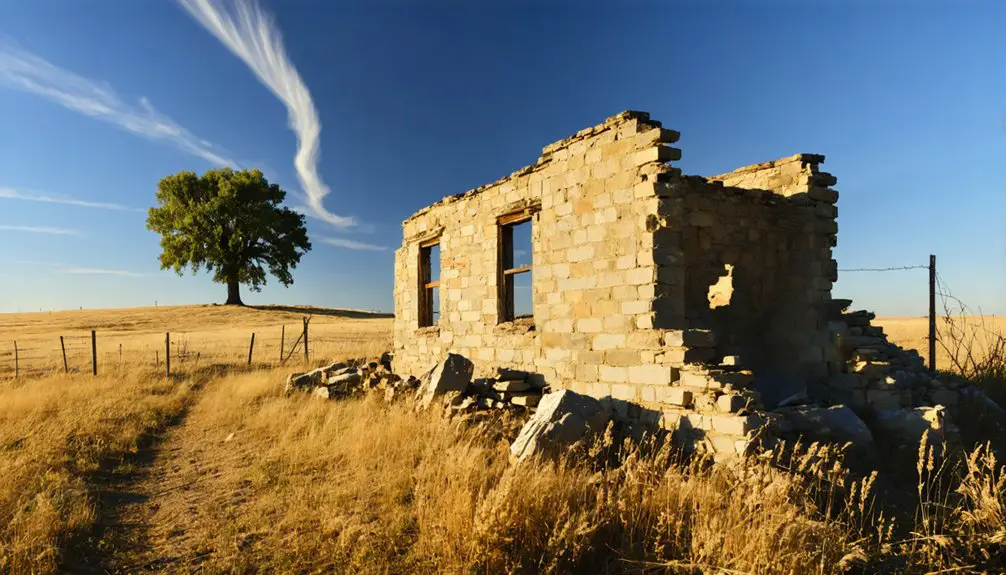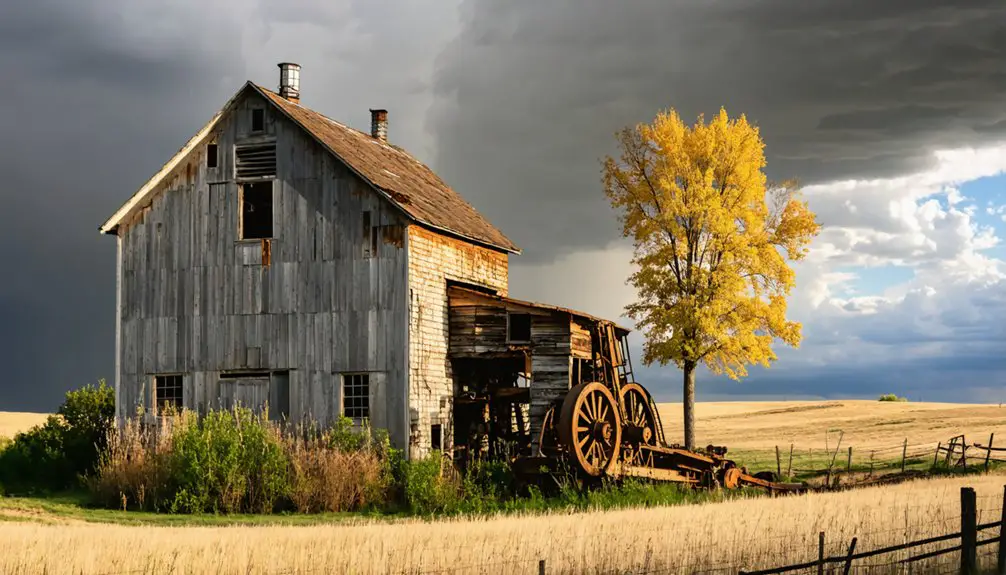You’ll find Annelly, Kansas in Harvey County’s past, where it emerged as a railroad settlement in 1885. Named by combining a railroad employee’s wife “Ann” and daughter “Ellie,” this small community thrived around the Missouri Pacific Railroad line between Newton and Whitewater. The town peaked with 25 residents by 1910, supporting a grain elevator, hotel, and general store. While its post office closed in 1921, Annelly’s story reveals deeper layers of Kansas railroad heritage.
Key Takeaways
- Annelly was founded in the 1880s as a railroad station along the Missouri Pacific line between Newton and Whitewater, Kansas.
- The town peaked at 25 residents in 1910, featuring a grain elevator, hotel, and general store during its most prosperous period.
- Named by combining “Ann” and “Ellie,” the town operated a post office from 1885 to 1921 before its decline.
- The 2003 abandonment of the railroad line marked the final blow to Annelly’s existence as a functioning community.
- Today, Annelly’s former location consists only of privately owned farmland with no visible remains of the railroad town.
The Birth of a Railroad Community
When the Missouri Pacific Railroad constructed its line between Newton and Whitewater in the 1880s, the small community of Annelly emerged along its tracks.
You’ll find its origins deeply rooted in railroad history, as a railroad employee named the settlement by combining his wife Ann’s and daughter Ellie’s names. Like Hesston’s founding, this development coincided with Missouri Pacific’s expansion in the region.
The town’s community identity quickly formed around its role as an essential railroad station. In 1885, the town established its post office operations, marking a significant step in its development.
Native Roots and Early Settlement
Before Annelly’s railroad era, nomadic Native American tribes traversed these plains for thousands of years, relying on buffalo hunting and seasonal resources while developing complex trade networks.
Similar to NS Town‘s history, the establishment of railroad infrastructure would prove crucial to the region’s development.
You’ll find the region’s earliest European claims came from France, which controlled the territory until ceding it to Spain in 1762, though it briefly returned to French hands before becoming part of the Louisiana Purchase in 1803.
Early American settlers began arriving in what would become Annelly only after the 1854 organization of Kansas Territory, transforming indigenous lands into agricultural parcels as U.S. expansion pushed westward.
The establishment of settlements intensified during the late 1880s when Indian Wars declined, creating more opportunities for westward expansion.
Original Plains Tribes
Four major tribes – the Kanza (Kaw), Osage, Pawnee, and Comanche – originally inhabited the Kansas plains before European settlement transformed the region.
You’ll find evidence of tribal migrations throughout the area, as the Lakota and other Siouan-speaking peoples moved westward due to eastern conflicts, while the Shoshone moved east, eventually giving rise to the Comanche around 1700.
The Kanza, who descended from the Omaha and Ponca, established cultural traditions along the Kansas River, living in circular lodges with central fire pits. French explorer Jean La Harpe described the warlike Osage tribe as instilling fear in neighboring tribes. The Kanza population saw a dramatic decline to fewer than 500 by 1873 after forced relocation to Indian Territory.
Their population reached 3,000 in the late 18th century before declining dramatically.
Other tribes, including the Wichita, Delaware, Iowa, and Kickapoo, also called these plains home, hunting buffalo and maintaining semi-nomadic lifestyles until European contact altered their traditional ways.
French Colonial Claims
The vast territory that encompassed modern-day Kansas first came under European influence through French colonial claims in the 16th century.
You’ll find that French exploration of this region was driven by fur trading interests rather than settlement, with notable explorers like Marquette, LaSalle, Dutisne, and DuBourgmont mapping the area between 1673 and 1724. French exploration of the territory actively began in 1673 with Marquette and continued through various expeditions.
This colonial influence shaped early development through the establishment of trading posts and small farming communities. Chez les Canses, a small French-speaking village focused on farming and fur trade, became the first permanent colony in the region.
While France’s control was primarily economic rather than population-based, you can still trace their legacy in place names and cultural institutions.
France’s claim to the region continued until 1762 when they ceded it to Spain, though they briefly regained control in 1802 before selling it to the United States through the Louisiana Purchase in 1803.
Pre-Railroad Settlement Patterns
While vast herds of buffalo once roamed freely across Kansas Territory, indigenous peoples had already established complex settlement patterns long before European arrival.
The south winds that swept across Kansas defined the very name and identity of the Kansa people. You’ll find the Kansa and Osage tribes were particularly prominent in central Kansas by the 1600s, creating a dynamic landscape of cultural exchanges through trade and seasonal migrations. Trading posts established by the French commander in 1724 near Kansa villages became vital centers of commerce.
Settlement dynamics in the region included:
- Kansa villages strategically positioned near river confluences for agriculture and trade
- Earth lodge communities serving as bases for seasonal hunting and tribal interactions
- Population centers of about 1,500 Kansa people maintaining traditional lifestyles
- Trading networks with French explorers, exchanging furs and other goods
From French Territory to American Soil
During the 16th through 18th centuries, French territorial claims stretched across vast portions of North America, including the region that would become Annelly, Kansas.
The French influence over this Great Plains territory shifted in 1762 when France secretly ceded the land to Spain through the Treaty of Fontainebleau. These territorial changes continued when Spain returned the region to France in 1802, setting the stage for a pivotal moment in American history.
You’ll find that the most significant transformation occurred in 1803 when the United States acquired the land through the Louisiana Purchase, paying just 2.83 cents per acre.
This acquisition paved the way for Kansas’s eventual organization as a territory in 1854 and its admission as the 34th state in 1861.
The Story Behind the Name

At its core, Annelly’s name represents a deeply personal tribute crafted by a Missouri Pacific Railroad employee who combined the names of his beloved wife Ann and daughter Ellie.
This personal connection exemplifies how individual stories shaped Kansas’ landscape during the railroad expansion era, differing from common naming traditions that often drew from indigenous words or natural landmarks.
Here’s what makes Annelly’s naming significant:
- Reflects the intimate relationship between railroad development and community formation
- Demonstrates how personal family bonds influenced Kansas geography
- Shows the shift from French-Spanish territorial names to settler-influenced designations
- Represents the broader trend of railroad employees leaving their mark on American towns
The name became official when the post office opened in 1885, cementing its place in Kansas history until the office’s closure in 1921.
Rail Line Legacy and Economic Growth
Once the Missouri Pacific Railroad established its line between Newton and Whitewater, Annelly emerged as an essential connection point that shaped Harvey County’s economic landscape. The railroad’s significance extended beyond mere transportation, as it catalyzed the development of important infrastructure including a grain elevator, hotel, and general store by 1910.
You’ll find that Annelly’s economic connectivity flourished during the railroad’s peak years, joining a broader network that included the Atchison, Topeka & Santa Fe main line and several other major railways crisscrossing Harvey County.
This rail system facilitated the transport of agricultural products, limestone, and gypsum while supporting passenger services that brought commercial importance to the region.
However, the town’s fortune would ultimately decline, culminating in the 2003 rail abandonment that stripped Annelly of its economic lifeline.
Agricultural Heritage and Local Life

The agricultural story of Annelly parallels many Kansas farming communities that experienced dramatic transformations throughout the 20th century.
Despite initial community resilience, agricultural innovation dramatically reshaped local life, leading to significant demographic shifts that would ultimately seal the town’s fate.
- Early settlers faced devastating challenges including prairie fires, severe storms, and grasshopper plagues in the 1870s.
- Mechanization and irrigation systems enabled fewer farmers to work larger acreages.
- Farm consolidation led to bigger operations but undermined small-town economies.
- The loss of essential services, including the post office’s closure in 1921, accelerated population decline.
You’ll find that Annelly’s agricultural heritage reflects a broader pattern where technological progress, while boosting productivity, paradoxically contributed to the dissolution of tight-knit farming communities.
Decline of the Missouri Pacific Era
You’ll find that Annelly’s fate became inextricably linked to Missouri Pacific’s declining rail operations, as the railroad’s strategic shift away from branch lines devastated local businesses that depended on rail connectivity.
Your understanding of Annelly’s transformation from vibrant transportation hub to ghost town must account for the broader pressures of the mid-20th century, when Missouri Pacific faced intense competition from highways and trucking.
When Missouri Pacific ultimately merged with Union Pacific in 1982, the final nail was driven into Annelly’s coffin as remaining local rail services were eliminated in favor of more profitable main routes.
Railroad Operations End Era
During Missouri Pacific Railroad‘s most challenging period, its once-extensive network began a steady decline from its 1930 peak mileage, ultimately shrinking by 32% to just 1,786 miles by 1974.
This economic shift reflected broader changes in America’s transportation landscape, as highways and air cargo diminished rail’s dominance.
Key developments in this railroad history included:
- Multiple bankruptcy declarations, most significantly during the 1933 Great Depression
- Consolidation of repair operations to Sedalia and North Little Rock, reducing local maintenance facilities
- Merger with Missouri-Kansas-Texas Railroad in 1988, marking the end of independent operations
- Widespread route abandonments affecting rural communities like Annelly, as the railroad shifted focus to profitable mainlines
These changes ultimately transformed Missouri Pacific from a regional powerhouse to a component of larger railroad systems.
Local Business Impact Analysis
While Missouri Pacific Railroad operations initially fueled Annelly’s economic growth, their decline triggered a devastating chain reaction throughout the local business community.
You’ll find that businesses dependent on rail connectivity, particularly grain elevators and supply stores, struggled with their sustainability once freight volumes diminished. The town’s economic resilience was severely tested as shipping costs increased and market access became limited.
When Missouri Pacific abandoned its tracks in 2003, local enterprises faced a stark choice: adapt or close.
Many couldn’t survive the shift to costlier truck transport. The impact rippled through Annelly’s agricultural sector, where farmers confronted higher expenses and logistical challenges.
The loss of rail service ultimately accelerated the town’s commercial decline, leading to widespread business closures and the community’s eventual transformation into a ghost town.
Transportation Hub Transformation
As the Missouri Pacific Railroad expanded through Harvey County in 1886, Annelly emerged as a strategic transportation stop between Newton and Whitewater. The railroad’s significance shaped community development throughout south central Kansas, establishing essential connections for goods and passengers before highways dominated transportation.
Consider these key alterations that affected Annelly’s role as a transportation hub:
- The Missouri Pacific merged with Union Pacific in 1997, leading to major rail line restructuring.
- Track abandonment between Newton and Whitewater in 2003 sealed Annelly’s fate.
- The wooden water tower’s relocation from Newton depot reflected the shift toward automobile traffic.
- Former rail-dependent land transformed into private farmland as Annelly became a ghost town.
These changes mirror broader shifts in rural Midwest transportation, where railroad consolidation and highway development reshaped local communities’ destinies.
Transportation Evolution and Impact
The Missouri Pacific Railroad‘s presence in Annelly proved essential to both the town’s establishment and its eventual decline. As a crucial transportation infrastructure hub in south central Kansas, Annelly’s station supported essential services including a general store, hotel, and grain elevator by 1910.
You’ll find that the railroad enabled the town to extend its economic reach beyond local markets, particularly for agricultural exports.
However, significant economic shifts occurred as transportation patterns evolved. While you could once witness horse-drawn buggies maneuvering rail crossings and grain shipments departing daily, the rise of highways and interstates gradually diminished rail’s importance.
When the Missouri Pacific line was abandoned in 2003, you’d see Annelly’s transformation complete – from thriving rail stop to ghost town, though its old railroad bed still traces through the landscape.
Harvey County’s Lost Settlement

Nestled in Richland Township, Harvey County, Kansas, Annelly stood nine miles southeast of Newton at coordinates 37°58′20″N 97°12′04″W.
This lost settlement reflects the cultural heritage of Harvey County’s railroad-era development, where community identity flourished briefly before fading into history.
- The town’s unique name came from a railroad employee who combined his wife Ann’s and daughter Ellie’s names.
- A post office operated from 1885 to 1921, marking the peak of community activity.
- The area transformed from Native American territory to French control before becoming part of the United States through the Louisiana Purchase.
- Today, you’ll find only privately owned farmland where this once-promising settlement stood, joining other ghost towns that dot Harvey County’s landscape.
Present-Day Remnants and Historical Records
Modern visitors to Annelly’s former location will find no trace of this once-active railroad community, as private farmland has completely reclaimed the area since its abandonment.
While remnant exploration isn’t possible due to private property restrictions, historical documentation provides a window into Annelly’s past. Records show that between 1885 and 1921, this small settlement maintained a post office and supported about 25 residents by 1910.
Historical records reveal Annelly’s modest population of 25 residents and its post office operations between 1885 and 1921.
You’ll find the town’s history preserved in Harvey County archives, which contain land records, probate documents, and marriage certificates from Annelly’s operational period.
The Missouri Pacific Railroad’s abandonment in 2003 removed the last major physical connection to the town’s past, though 60th Street remains as a silent witness to this lost Kansas settlement.
Frequently Asked Questions
What Was the Highest Recorded Population of Annelly During Its Peak?
You won’t find Annelly’s peak population in historical records, as documentation of its history is limited. The town experienced population decline until becoming a ghost town after railroad operations ceased.
Were There Any Schools or Churches Established in Annelly?
Despite records covering 36 years of Annelly’s history from 1885-1921, you won’t find evidence of established schools or churches there. Residents likely relied on nearby Newton for educational and religious services.
What Natural Disasters or Significant Weather Events Affected Annelly?
While you’d expect tornado impacts and drought effects in Kansas’s Tornado Alley, there’s no documented evidence of specific natural disasters directly striking Annelly during its inhabited period through 2003.
Did Any Notable Historical Figures Ever Visit or Live in Annelly?
While larger Kansas towns drew famous visitors and historical events, you won’t find any documented evidence of notable figures ever living in or visiting Annelly during its small railroad town existence.
What Businesses and Services Operated in Annelly Besides the Post Office?
You’d find a grocery store, hotel, grain elevator, lumber yard, doctor’s office, attorney, drugstore, barbershop, blacksmith shop, dance halls, bars, gambling houses, brothels, and multiple banks serving the community.
References
- https://en.wikipedia.org/wiki/Annelly
- https://www.wikiwand.com/en/articles/Annelly
- https://alchetron.com/Annelly
- https://en.wikipedia.org/wiki/List_of_ghost_towns_in_Kansas
- https://legendsofkansas.com/harvey-county-kansas/
- https://fhsuguides.fhsu.edu/kansasheritage/harveycounty
- https://en.wikisource.org/wiki/Kansas:_A_Cyclopedia_of_State_History/Annelly
- https://hchm.org/tag/harvey-county-railroad/
- https://www.youtube.com/watch?v=VPZtNoncnig
- https://www.visitgck.com/eminence-and-ravanna-the-story-of-finney-countys-ghost-towns/



